Analytical Model of the Electro-Mechanical Impedance Response of Frame Structures with L-Shaped Beams
IF 1.6
4区 材料科学
Q3 MATERIALS SCIENCE, CHARACTERIZATION & TESTING
引用次数: 2
Abstract
ABSTRACT The electro-mechanical impedance (EMI) method has been accepted as an effective technique for detecting damages in the Structural health monitoring (SHM). EMI at any point of the structure depends on material properties, geometry and boundary conditions that all appears in dynamic stiffness of the structure. In spite of the expensive experimental methods for measuring the mechanical impedance, or the cheaper one electromechanical impedance, of structures, various analytical methods could be substitutions for them. In this paper, an analytical method is developed to obtain the EMI response of L-shaped beams through calculating the dynamic stiffness of the structure. To verify the model, an experimental setup with an embedded piezoelectric wafer active sensor (PWAS) is carried out. The results have shown that EMI and its real part, extracted by the current analytical method, are with good agreement of the experimental results. Also, the dynamic stiffness of the structure directly depends on the mode shapes of the structure and its natural frequencies in terms of the excitation frequency. The peaks of the real part of the EMI results related to the coincidence between agitation frequency value and natural frequencies of the structure.l型梁框架结构机电阻抗响应分析模型
机电阻抗法(EMI)是结构健康监测(SHM)中检测损伤的一种有效方法。结构任何一点的电磁干扰取决于材料特性、几何形状和边界条件,这些都出现在结构的动刚度中。尽管测量结构的机械阻抗或机电阻抗的实验方法昂贵,但各种分析方法都可以替代它们。本文提出了一种通过计算结构的动刚度来获得l型梁电磁干扰响应的解析方法。为了验证该模型,建立了嵌入式压电片有源传感器(PWAS)实验装置。结果表明,用现有的分析方法提取的电磁干扰及其实部与实验结果吻合较好。此外,结构的动刚度直接取决于结构的模态振型及其以激励频率表示的固有频率。电磁干扰实部的峰值与搅拌频率值与结构固有频率的吻合有关。
本文章由计算机程序翻译,如有差异,请以英文原文为准。
求助全文
约1分钟内获得全文
求助全文
来源期刊

Research in Nondestructive Evaluation
工程技术-材料科学:表征与测试
CiteScore
2.30
自引率
0.00%
发文量
14
审稿时长
>12 weeks
期刊介绍:
Research in Nondestructive Evaluation® is the archival research journal of the American Society for Nondestructive Testing, Inc. RNDE® contains the results of original research in all areas of nondestructive evaluation (NDE). The journal covers experimental and theoretical investigations dealing with the scientific and engineering bases of NDE, its measurement and methodology, and a wide range of applications to materials and structures that relate to the entire life cycle, from manufacture to use and retirement.
Illustrative topics include advances in the underlying science of acoustic, thermal, electrical, magnetic, optical and ionizing radiation techniques and their applications to NDE problems. These problems include the nondestructive characterization of a wide variety of material properties and their degradation in service, nonintrusive sensors for monitoring manufacturing and materials processes, new techniques and combinations of techniques for detecting and characterizing hidden discontinuities and distributed damage in materials, standardization concepts and quantitative approaches for advanced NDE techniques, and long-term continuous monitoring of structures and assemblies. Of particular interest is research which elucidates how to evaluate the effects of imperfect material condition, as quantified by nondestructive measurement, on the functional performance.
 求助内容:
求助内容: 应助结果提醒方式:
应助结果提醒方式:


